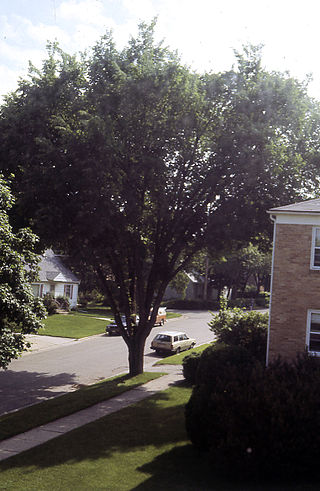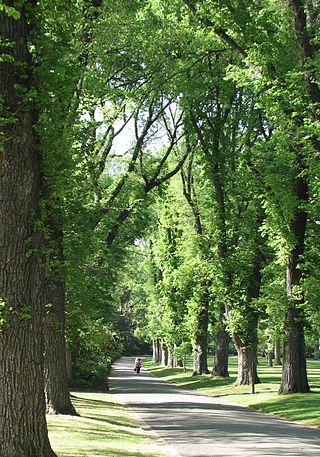
Ulmus americana, generally known as the American elm or, less commonly, as the white elm or water elm, is a species of elm native to eastern North America, naturally occurring from Nova Scotia west to Alberta and Montana, and south to Florida and central Texas, and is the State Tree of Massachusetts. The American elm is an extremely hardy tree that can withstand winter temperatures as low as −42 °C. Trees in areas unaffected by Dutch elm disease (DED) can live for several hundred years. A prime example of the species was the Sauble Elm, which grew beside the banks of the Sauble River in Ontario, Canada, to a height of 43 m (140 ft), with a d.b.h of 196 cm (6.43 ft) before succumbing to DED; when it was felled in 1968, a tree-ring count established that it had germinated in 1701.

Ulmus rubra, the slippery elm, is a species of elm native to eastern North America. Other common names include red elm, gray elm, soft elm, moose elm, and Indian elm.

Ulmus × hollandica 'Vegeta', sometimes known as the Huntingdon Elm, is an old English hybrid cultivar raised at Brampton, near Huntingdon, by nurserymen Wood & Ingram in 1746, allegedly from seed collected at nearby Hinchingbrooke Park. In Augustine Henry's day, in the later 19th century, the elms in Hinchingbrooke Park were U. nitens. Richens, noting that wych elm is rare in Huntingdonshire, normally flowering four to six weeks later than field elm, pointed out that unusually favourable circumstances would have had to coincide to produce such seed: "It is possible that, some time in the eighteenth century, the threefold requirements of synchronous flowering of the two species, a south-west wind", "and a mild spring permitting the ripening of the samaras, were met."

The Field Elm cultivar Ulmus minor 'Sarniensis', known variously as Guernsey elm, Jersey elm, Wheatley elm, or Southampton elm, was first described by MacCulloch in 1815 from trees on Guernsey, and was planted in the Royal Horticultural Society's gardens in the 1820s. It was listed in the Loddiges catalogue of 1836 as Ulmus sarniensis and by Loudon in Hortus lignosus londinensis (1838) as U. campestris var. sarniensis. The origin of the tree remains obscure; Richens believed it "a mutant of a French population of Field elm", noting that "elms of similar leaf-form occur in Cotentin and in northern Brittany. They vary much in habit but some have a tendency to pyramidal growth. Whether the distinctive habit first developed on the mainland or in Guernsey is uncertain."

The American Elm cultivar Ulmus americana 'Princeton' was originally selected in 1922 by New Jersey nurseryman William Flemer of Princeton Nurseries for its aesthetic merit. 'Princeton' was later found to have a moderate resistance to Dutch elm disease (DED).

The American elm cultivar Ulmus americana 'New Harmony' was raised by the Maryland Agricultural Research Service and released by the United States National Arboretum in 1995, along with 'Valley Forge'. 'New Harmony' proved the most successful U. americana cultivar in the US National Elm Trial, averaging a survival rate of 85.5% overall.

The American elm cultivar Ulmus americana 'Brandon' was raised by Lacombe Nurseries Lacombe, Alberta, Canada, before 1969; it may be synonymous with another cultivar from the same source known as 'Patmore', selected and raised by R. H. Patmore from a native tree in Brandon, Manitoba.

The American elm cultivar Ulmus americana 'Lewis & Clark' is a development from the North Dakota State University (NDSU) Research Foundation breeding programme, released in 2004 to commemorate the 200th anniversary of the eponymous expedition. The cultivar was cloned from a tree discovered in 1994 along the Wild Rice River south west of Fargo, North Dakota, where all those around it had succumbed to Dutch elm disease; the tree remains in perfect health (2008). Prairie Expedition proved only moderately successful in the US National Elm Trial, averaging a survival rate of 62.6% overall, potentially due to environmental factors rather than susceptibility to Dutch elm disease.
The American Elm cultivar Ulmus americana 'Lake City' is a semi-fastigiate form cloned in the early 1920s from a ten-year old seedling found growing outside the Lutheran parsonage, Lake City, Minnesota, and released by the Lake City Nurseries there in 1931. The Nurseries published a nine-page booklet on it in 1932, 'The Lake City Elm', with full description, a photograph of the original tree, and commendatory letters. It was later described by Wyman in Trees Magazine 3 (4): 13, 1940.
The American Elm cultivar Ulmus americana 'Littleford' was cloned from a tree in Hinsdale, Illinois, circa 1915 by Littleford Nurseries of Downers Grove, Illinois, and first released in 1927. It was marketed in the 1930s by nearby Hinsdale Nurseries, successor to Littleford Nurseries, as 'Littlefordii'. In their 1925 catalogue Littleford Nurseries had written of their selection: "The growing of the American elm is a specialty with us; we consider it the leading shade and ornamental tree. Our trees are a selected strain of the V-shaped type, a stock of 15 to 20 thousand, all 2 ins. and up in size, transplanted twice and in splendid vigor for planting".

The American Elm cultivar Ulmus americana 'Moline' was cloned from a wild seedling transplanted to Moline, Illinois, from nearby Rock River Valley in 1903 and propagated from 1916 by the Klehm Nurseries, Arlington Heights, Illinois.
The American Elm cultivar Ulmus americana 'Minneapolis Park', originally called 'Minneapolis Park Board Selection', was a cold-hardy clone selected before 1930 by Theodore Wirth, Superintendent of the Minneapolis Park Department, to replace the 'Moline' elms killed in the 1920s by Minneapolis winters.
The American Elm cultivar Ulmus americana 'Star' was a selection made by the Plumfield Nursery, Fremont, Nebraska, c. 1945.

The American Elm cultivar Ulmus americana 'Vase' was selected and propagated in the early 20th century by the Klehm Nurseries, Arlington Heights, Illinois, who advertised it at first as Ulmus americana 'Urnii', 'Klehms' American Vase-Shaped Elm', listing it, along with its stablemate Ulmus americana 'Moline', as a "novelty" in 1926, and describing both in some detail. Its original cultivar name, 'Urnii' – doubtful Latin – was changed to 'Vase' by Klehms by the 1930s, the tree also featuring as 'Vase Elm' in the catalogues of the Plumfield Nurseries, Fremont, Nebraska, from 1926, along with Klehms' 'Moline'. Vaughan's of Chicago marketed both from 1927. The Naperville Nurseries of Naperville, Illinois, marketed it from 1929 as 'Klehmii', 'Vase Elm', also introducing Klehms' 'Moline' at the same time.
The hybrid elm cultivar Ulmus 'Hamburg' was originally raised by the Plumfield Nurseries, Fremont, Nebraska, circa 1932, after its discovery by Mr. Lloyd Moffet in a bed of Siberian Elm Ulmus pumila seedlings from Tekamah. It was later marketed by Interstate Nurseries, Hamburg, Iowa, from 1948, as 'Interstate's New Hamburg Hybrid Elm'. Green stated that it was originally said be a hybrid of Ulmus pumila and Ulmus americana, but the Hamburg Nurseries of Iowa made no such claim for it in their catalogues from 1948 onwards. It is now considered more likely that Ulmus rubra was the male parent, as it was also known as 'Hybrid Chinese Elm', and therefore probably synonymous with Plumfield Nurseries' 'Hybrid elm' of the same date, a known crossing of U. pumila and U. rubra, – and so, perhaps, also synonymous with Ulmus × intermedia 'Fremont', an elm of the same parentage found a little later in Plumfield Nurseries.

The American elm cultivar Ulmus americana 'Pendula' was originally listed by William Aiton in Hort. Kew, 1: 320, 1789, as U. americana var. pendula, cloned in England in 1752 by James Gordon. From the 1880s the Späth nursery of Berlin supplied a cultivar at first listed as Ulmus fulva (Michx.) pendulaHort., which in their 1899 catalogue was queried as a possible variety of U. americana, and which thereafter appeared in their early 20th-century catalogues as U. americana pendula. The Scampston Elm, Ulmus × hollandica 'Scampstoniensis', in cultivation on both sides of the Atlantic in the 19th and 20th centuries, was occasionally referred to as 'American Weeping Elm' or Ulmus americana pendula. This cultivar, however, was distinguished by Späth from his Ulmus americana pendula.

The cultivation of elms in Australia began in the first half of the 19th century, when British settlers imported species and cultivars from their former homelands. Owing to the demise of elms in the northern hemisphere as a result of the Dutch elm disease pandemic, the mature trees in Australia's parks and gardens are now regarded as amongst the most significant in the world.

The hybrid elm cultivar Ulmus × intermedia 'Fremont' is a little-known American hybrid cultivar propagated from a tree found on the Lloyd Moffet property at Fremont, Nebraska. The hybrid is believed to have arisen from a crossing of Ulmus pumila and one of the spring-flowering elms native to North America, probably Ulmus rubra. The source tree was probably an unsold specimen of the Plumfield Nurseries' "Hybrid Elm", a cross between "Chinese elm" and Red elm U. rubra, briefly marketed from 1942 to 1943, but not appearing in later catalogues. This hybrid may have been the same as the cultivar sourced from Plumfield Nurseries at this time as "Hybrid Chinese Elm" and later marketed by the Interstate Nurseries, Hamburg, Iowa, as 'Hamburg'.
The American Elm cultivar Ulmus americana 'Great Plains' was a clone raised by nurseryman Wedge of the Oscar H. Will & Co. Nurseries, Bismarck, North Dakota, in the 1930s and first listed in the company's 1942 catalogue as 'Great Plains American Elm'.














